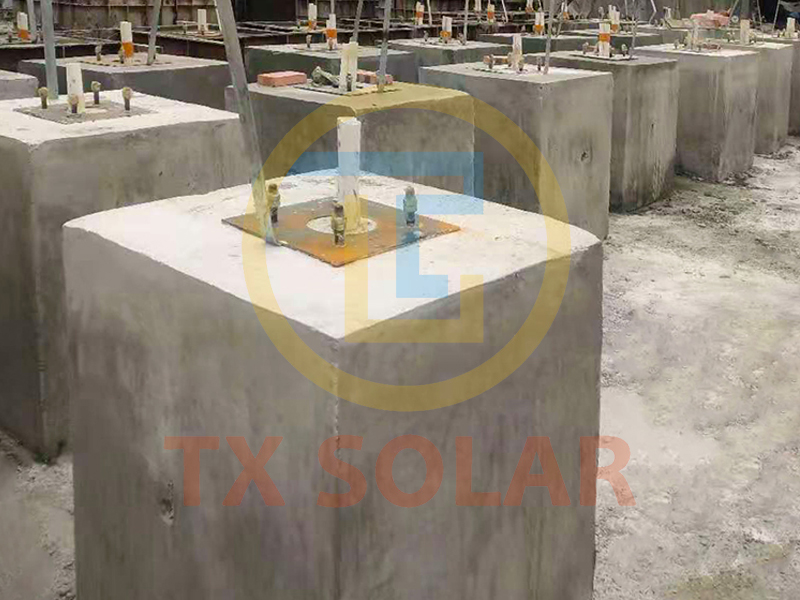Pals de llumsón habituals a les ciutats i als suburbis, i proporcionen il·luminació essencial als carrers, aparcaments i altres zones públiques. Aquestes estructures estan dissenyades per suportar diverses condicions meteorològiques i activitats humanes. Un aspecte important d'un pal de llum és la seva base, que és crucial per mantenir el pal estable i dret. Si us pregunteu quina profunditat té la base d'un pal de llum, continueu llegint per obtenir més informació sobre aquest component important.
La profunditat de la base d'un pal de llum depèn de diversos factors, com ara l'alçada del pal de llum, el tipus de sòl, els codis de construcció locals i els requisits específics del fabricant del pal de llum. En general, la base d'un pal de llum ha de ser prou profunda per proporcionar un suport i una estabilitat adequats, especialment en zones on les càrregues de vent són elevades o és probable que es produeixin moviments de terreny.
En la majoria dels casos, la profunditat de la base del pal de llum oscil·la entre els 90 i els 150 cm, però aquesta profunditat pot variar molt segons els factors esmentats anteriorment. Els pals més alts i els que es troben en zones amb sòl més solt o inestable poden requerir bases més profundes per garantir un suport adequat. A més, algunes zones poden tenir regulacions o codis de construcció específics que dicten la profunditat necessària de les bases dels pals de llum per garantir la seguretat pública.
La base d'un pal de llum sol ser de formigó, abocat en un forat excavat a terra. Les dimensions de la base, incloent-hi l'amplada i la profunditat, es calculen acuradament per proporcionar el suport i l'estabilitat necessaris per al pal. Després d'abocar i endurir el formigó, els pals s'instal·len i es connecten a la base, completant el procés d'instal·lació.
A l'hora de determinar la profunditat de la base d'un pal de llum, cal tenir en compte les condicions específiques del sòl del lloc d'instal·lació. Els diferents tipus de sòl tenen diferents capacitats de càrrega, i alguns poden requerir una fonamentació més profunda per garantir l'estabilitat del pal. Per exemple, els sòls amb un alt contingut d'argila poden requerir una base més profunda per proporcionar un suport adequat, mentre que els sòls que es compacten bé poden requerir una base menys profunda.
En zones propenses a vents forts o terratrèmols, la profunditat de la base del pal de llum és un factor important per garantir la seguretat i l'estabilitat de l'estructura. La base profunda ajuda a evitar que el pal es bolqui durant vents forts o moviments del terreny, reduint el risc de danys i lesions.
A més de la profunditat de la base, l'amplada de la base també és una consideració important. Una base més ampla proporciona una estabilitat i una capacitat de càrrega addicionals, especialment en zones amb condicions de sòl difícils. El disseny de la base, inclosa la seva mida i forma, està acuradament dissenyat per satisfer els requisits específics del lloc d'instal·lació.
Cal destacar que la profunditat i les dimensions de la base d'un pal de llum solen ser determinades per un enginyer o instal·lador qualificat, que tindrà en compte tots els factors rellevants per garantir la seguretat i l'estabilitat del pal de llum. Això inclou la realització de proves de sòl, l'avaluació dels codis de construcció locals i el seguiment de les pautes d'instal·lació proporcionades pel fabricant del pal.
En resum, la profunditat de la base d'un pal de llum pot variar en funció de diversos factors, com ara l'alçada del pal, les condicions del sòl i els codis de construcció locals. En general, les bases dels pals de llum solen tenir una profunditat d'entre 90 i 150 cm, però això pot variar en funció de requisits específics. La profunditat i les dimensions de la base s'han calculat acuradament per proporcionar al pal el suport i l'estabilitat necessaris, garantint la seva seguretat i funcionalitat. Si esteu pensant en instal·lar un pal de llum, assegureu-vos de consultar un professional qualificat per determinar la profunditat adequada de la base en funció de les condicions específiques del lloc d'instal·lació.
Data de publicació: 15 de desembre de 2023

